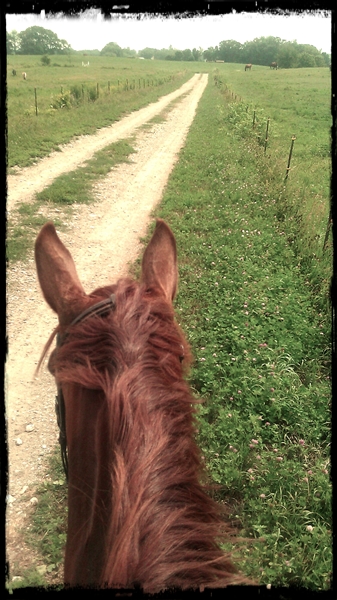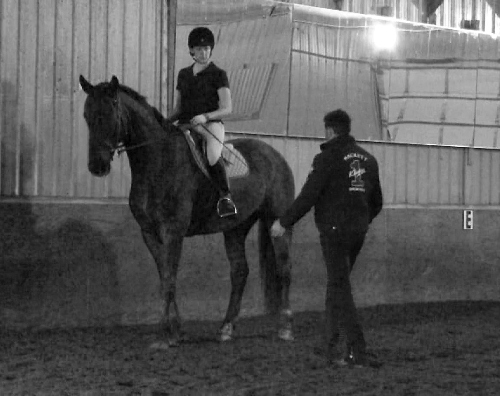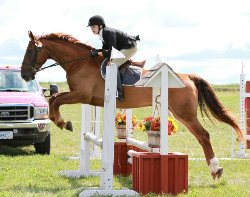Catch-All
So, once again, bad blogger. A lot’s happened since my last update…
First, I rode in a clinic with David DeWispelaere in April. I really enjoyed it, and intended for a long time to write about it — but less than a week after the clinic, Poe came out of the pasture lame. NOT HAPPY. I’d taken him out back for walking and trotting hill work on Tuesday and had a really nice jumping lesson on Wednesday. He felt a bit sluggish by the end of the lesson, so he got Thursday off. Then Friday, lame. LAME. I called my friend Lennie, who happens to be one of the most knowledgeable horsepeople I know, and she graciously came out to the barn to watch him jog. It was definitely left hind (my eye for lameness is terrible, but this was pronounced enough even I could see it). He didn’t seem to want to place the foot, so Lennie felt it was an abscess brewing, and best thing for it would be chuck him back out in the field and wait.
The next Wednesday he was still about the same, maybe a touch better than that first day. The vet was coming out to float his teeth anyhow, so I called ahead to ask that he watch Poe jog, throw the hoof testers on him, etc before doing his teeth. The vet kindly squeezed it in. He saw the same left hind lameness, but couldn’t find any reactivity with the hoof testers, no heat, no swelling, no difference in pulse between the legs. He didn’t have time for further diagnostics and couldn’t tell anything based on what he’d seen. So I set up an appointment the following Monday (soonest I could get someone), and put him on a couple days of bute.
Monday the second vet watched him jog on and off the lunge, did the hoof testers, and did some flexions. Poe was a total brat about flexing his left stifle. He wasn’t fantastic about his right either, but worse for the left. No real heat or swelling, and no difference in the jog before and after the flexion, but he also wasn’t able to hold it all that long. Inconclusive. We were set to do nerve blocks next, but Poe was a bit fried and refused to have the twitch put on, and reacted rather violently to the vet’s attempt to get the needle in without the twitch, so we scrapped that. He is usually an easy horse to handle so the whole exam was a bit disheartening. Much moreso because we were no closer to an answer than we’d been last week. The vet advised I give it another couple of days, and set another appointment if there was no change, possibly bring him in for x-rays.
By Wednesday there was no difference. I don’t have a truck and trailer, so hauling him up to the clinic was not a great option. A third vet was able to schedule to see him on Saturday. He’s the one who usually handles emergencies so they don’t schedule him, but I was very flexible about when I could see him so he worked me in. He repeated everything we’d done Monday, with a bit better success on the flexions, since Poe was feeling more cooperative. Same result: he flexed fine. Back in the barn the vet pulled out the hoof testers — and voila! Tenderness in the left hind. It was the first time Poe had reacted to them, but there was a definite, repeatable reaction. Probably a stone bruise. And a huge, huge relief. The vet had also brought out the thermography camera, so he had a look at both of Poe’s back legs with that. Really cool little device — and also a relief to see no difference in heat between the legs. The vet felt there was a small amount of swelling in the left stifle, but nothing super alarming.
He prescribed a 3-week course of bute (2gm twice a day for three doses, then 2gm once a day for 10 days, then 1gm once a day for 10 days), and said I should ride him. Nothing super strenuous, stick to large figures, no jumping — but he felt the bute would address any inflammation, and that moving would help him strengthen/loosen whatever he’d tweaked, and things would either improve and be fine or get worse so we might have a clue what else was going on. We discussed other options too — injecting the stifle, taking him in for x-rays — but we both felt this was the best next step. So, after over 2 weeks out of the saddle, I got to climb on the pony-face again! It was a fantastic feeling just to walk and trot him around the arena.
That was mid-May. I honestly feel like we’ve still been getting back into work since then, which is kind of pathetic since it’s been 2 months and he wasn’t out of work that long. I feel like he’s had good days and bad days, though. He’s consistently more comfortable on the footing in the indoor, but sometimes he feels pretty great in the outdoor too. We went back to jumping a month ago. We haven’t done a lot, but he is SO so excited and happy every time we do.
I’m still freaked out that my horse is secretly broken, though. Every tiny bobble and misstep scares me. I’m terrified I’m doing wrong by him somehow, that I will ruin him. So, I’m trying to take things in baby steps. Baby baby steps. I’ve launched Operation: Super-Stifle! and am walking him up and down the hills out back at least once a week. It’s something we can do even in this insane heatwave. (A couple weeks ago we had a heat advisory all week, with temps around 100 and insane humidity — so that was a week of a lot of baths and zero riding, which hasn’t helped the feeling that we’re woefully unprepared for anything right now.) This Sunday we’re going cross-country schooling at Steepleview. I’m prepared to quit the minute he starts feeling tired. I’m also using it to gauge whether or not to sign up for their recognized show over Labor Day weekend. Some moments I feel like it would be the most fun thing ever and we just have to go do it — and other moments I remember how showing leaves me wanting to vomit the entire week beforehand, and pretty much every moment during it that we aren’t running cross-country. Still, if I never show the nerves will never get better.
To that end I did a little ride-a-test schooling thing a few weeks ago at my barn. You could pick any test, ride it once for the judge, get feedback and a mini-lesson about how to improve that test immediately, then ride it again. I had the best score ever, and while I was tense I did not entirely lose my mind when we hit the ring, so it was an improvement. It helps that the judge was Jodi, who I used to train with. And she had some awesome advice for us, and some really concrete specific thing we should be working on. Namely: shoulder-fore at the canter, especially on the right lead. Do not let him trick me into hold his head up with the inside rein to that direction. Use the long walls instead of circles until he’s more balanced. We have not been doing this enough — I know it will help us enormously, and need to start busting it out now that the weather’s broken.
Okay, this was a really rambling catch-all, but I think I hit all the highlights of the last couple months. Oh! Except the saddle! I bought a dressage saddle. Update for another time.


